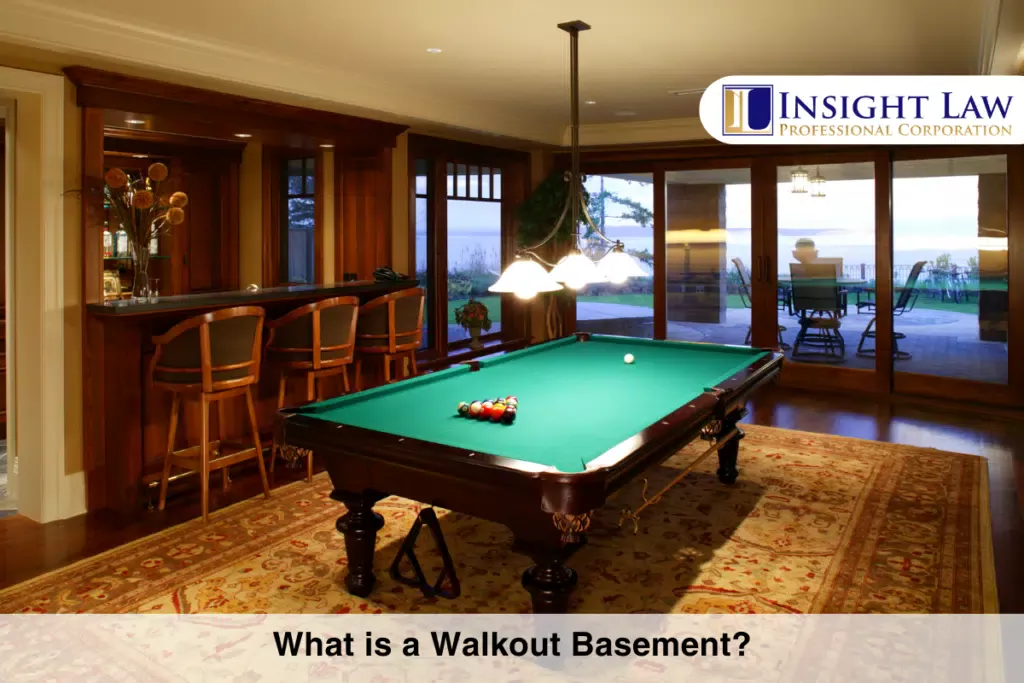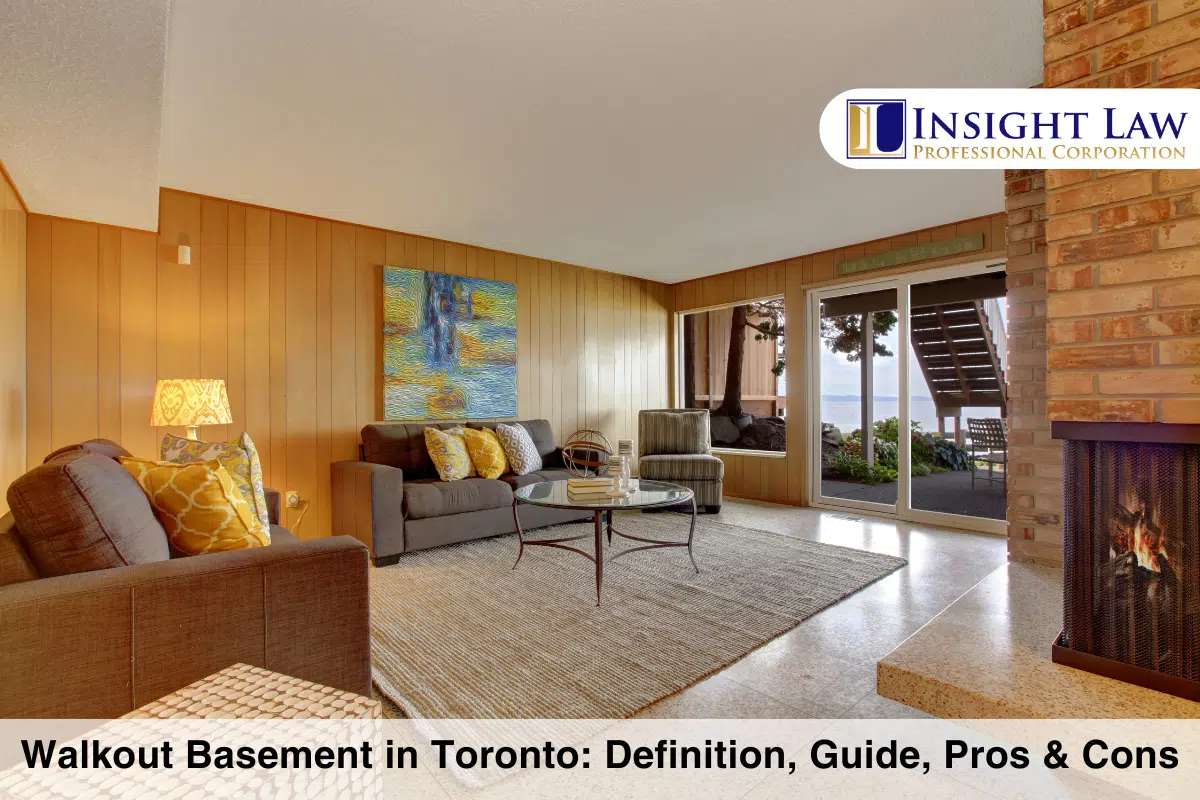Walkout basements are attractive in many Toronto homes, providing additional living space with direct outdoor access. Unlike traditional basements that are entirely below ground level, walkout basements have at least one exterior wall above ground, allowing for a door and windows. This unique design offers various benefits, including increased natural light and improved home value, but it also comes with its own set of challenges, such as higher construction costs and potential drainage issues. This guide will explore the definition of walkout basements, provide a comprehensive guide to creating one, and discuss the pros and cons of this popular home feature.
What is a Walkout Basement?

A walkout basement is a type of basement that features at least one exterior wall fully above ground level, which allows for installing a door and windows that provide direct access to the outdoors. This design contrasts with traditional basements, which are entirely or mostly below ground and accessible only from within the house. Walkout basements benefit from increased natural light and ventilation, making them more suitable as additional living spaces such as family rooms, guest suites, or rental units. They are particularly popular in homes built on sloped lots, where the natural terrain accommodates the walkout design.
What are the Benefits of Walkout Basement?
Some of the benefits of walkout basement include:
Increased Natural Light
Walkout basements have large windows and doors that allow sunlight to penetrate deep into the space, reducing the need for artificial lighting during the day. This natural illumination can make the basement feel more like a main-level room than a subterranean space. The abundance of daylight also creates a more inviting and comfortable atmosphere, making the basement suitable for various uses, from living areas to home offices.
Additional Living Space
The versatile nature of walkout basements means they can be adapted to suit numerous functions. Homeowners can transform these areas into extra bedrooms, entertainment rooms, fitness centers, or even kitchens and bathrooms, thereby increasing the functional living space of their homes. This flexibility allows families to expand their living quarters without needing a costly addition or new construction.
Improved Home Value
Homes with walkout basements often fetch higher prices on the real estate market due to the added usable space and enhanced aesthetic appeal. Real estate agents frequently highlight walkout basements as a premium feature because they provide more options for potential buyers, such as the ability to create rental units or additional family living space. This can make the property more attractive and competitive in the housing market.
Enhanced Accessibility
A walkout basement provides direct access to the outdoors, which is particularly beneficial for homeowners with mobility issues, as it eliminates the need to navigate stairs to enter the basement. This ease of access can also benefit families with children, allowing easy entry and exit to the backyard or garden. The walkout feature can also be a convenient entry point for guests or service providers, reducing traffic through the main living areas.
Potential Rental Income
Walkout basements can be converted into fully self-contained rental units with separate entrances, kitchens, and bathrooms. This setup is ideal for generating additional income by renting out the space to tenants. The privacy afforded by a separate entrance makes these units particularly attractive to renters, providing homeowners with a steady stream of rental income without significantly impacting their living space.
Better Ventilation
The windows and doors in walkout basements allow for better airflow and ventilation than traditional basements, which are often poorly ventilated and prone to dampness. Improved ventilation helps to maintain a healthy indoor environment by reducing humidity levels and preventing the growth of mould and mildew. This makes the basement a more comfortable and healthier place to live or work, enhancing its usability and appeal.
What are the Cons of Walkout Basement?
Some of the cons of walkout basement include:
Higher Construction Costs
Building or converting a walkout basement involves significant excavation and structural modifications, which can be expensive. The additional costs include reinforcing the foundation, ensuring proper drainage, installing large windows and doors, and finishing the interior space. These expenses can be considerably higher than those for traditional basements, making the initial investment substantial.
Drainage and Moisture Issues
Walkout basements are more exposed to the elements, increasing the risk of water infiltration. Proper drainage systems, such as French drains or sump pumps, are essential to prevent flooding and moisture problems. If not correctly addressed, water issues can lead to mould growth, structural damage, and a decrease in indoor air quality, requiring ongoing maintenance and repairs.
Privacy Concerns
The increased accessibility of a walkout basement can lead to privacy issues, especially if the basement is used as a rental unit or guest suite. Tenants or guests entering and exiting through the basement door may reduce the homeowner’s privacy. Additionally, large windows can make it easier for outsiders to see into the basement, necessitating window coverings or strategic landscaping for privacy.
Security Risks
The exterior door and large windows in a walkout basement can present security vulnerabilities. These entry points may be more accessible to intruders than those in traditional basements. Homeowners must invest in robust security measures, such as high-quality locks, security cameras, and alarm systems, to mitigate these risks and ensure the safety of their property.
Temperature Regulation
Walkout basements may be more challenging to keep at a comfortable temperature due to their exposure to outdoor conditions. Proper insulation and HVAC systems are crucial to maintaining a stable indoor temperature. Without adequate insulation, the basement can become too cold in winter and warm in summer, leading to higher energy costs and reduced comfort.
Zoning and Permit Challenges
Converting a basement into a walkout basement often requires obtaining various permits and complying with local zoning regulations. This process can be time-consuming and complex, involving multiple inspections and adherence to building codes. Homeowners must navigate these legal hurdles to ensure their project is compliant, which can delay construction and add to the overall cost.
How to Build a Walkout Basement Within an Existing Home
Building a walkout basement within an existing home requires careful planning, professional expertise, and a series of well-executed steps to ensure the project is feasible and compliant with local regulations. The first step is to conduct a thorough site assessment to determine if the existing landscape and structural foundation can support a walkout basement. Properties on sloped terrain are ideal for such projects. Engage with a structural engineer or an architect to evaluate the feasibility and design a plan that includes necessary structural reinforcements, proper drainage systems, and the incorporation of windows and doors for the walkout. Obtaining the required permits from local authorities is crucial before construction begins, as ensuring that all work meets the Ontario Building Code and local zoning bylaws.
Once the planning and permits are in place, the construction phase involves significant excavation to create the walkout level. This step requires precision to maintain the integrity of the existing foundation while creating space for the new entrance. Structural modifications, such as reinforcing the foundation and installing retaining walls, are essential to prevent soil erosion and ensure stability. Installing proper drainage systems, such as French drains or sump pumps, is vital to prevent water infiltration and moisture issues. After the structural elements are secure, the interior can be finished according to the intended use, with considerations for insulation, waterproofing, and ventilation to create a comfortable and livable space. By following these steps and working with experienced professionals, homeowners can successfully add a walkout basement to their existing home, enhancing its functionality and value.
What Are the Property Requirements for a Walkout Basement?
Certain site-specific conditions and structural requirements must be met to add a walkout basement to a property successfully. One of the primary considerations is the terrain of the property. A sloped lot is ideal, as it naturally accommodates the walkout basement design by allowing one side of the basement to be at ground level. This slope facilitates the creation of an exterior wall with doors and windows, providing direct outdoor access. Properties that are flat or have minimal grade variation may require extensive excavation and landscaping to create the necessary slope, which can significantly increase construction costs and complexity.
In addition to terrain, the structural integrity and design of the existing home are crucial factors. The foundation must be strong enough to support the modifications needed for a walkout basement, including adding large openings for doors and windows. It’s essential to assess the foundation to identify any necessary reinforcements thoroughly. Adequate drainage is also a critical requirement; the site must be capable of supporting effective drainage solutions to prevent water infiltration and potential flooding. This often involves installing French drains and sump pumps and grading the surrounding landscape to direct water away from the basement. Compliance with local building codes and zoning regulations is mandatory, so obtaining the necessary permits and approvals from local authorities is a key step in planning. These requirements ensure the walkout basement is functional, aesthetically pleasing, safe, and legally compliant.
What are the Legal Considerations of Walkout Basement?
Constructing a walkout basement involves several legal considerations to ensure compliance with local regulations and avoid potential legal issues. Homeowners must navigate various building codes, zoning bylaws, and permit requirements. Here are the key legal considerations:
Building Permits
Before beginning construction, homeowners must obtain the necessary building permits from the local municipality. This process typically involves submitting detailed plans that outline the project’s scope, including structural changes, drainage systems, and safety measures. The plans must comply with the Ontario Building Code, which sets construction quality and safety standards.
Zoning Bylaws
Zoning bylaws regulate land use and building standards in specific areas. Homeowners must ensure that their property is zoned for the type of construction they are planning. This includes checking for basement apartment restrictions, property line setbacks, and maximum building heights. Zoning bylaws may also dictate the minimum size and occupancy requirements for any new living spaces created by the walkout basement.
Secondary Suite Regulations
If the walkout basement is intended to be used as a secondary suite or rental unit, it must comply with specific regulations. These regulations typically cover fire safety, such as installing smoke alarms, fire exits, and requirements for egress windows. There are also standards for ceiling heights, ventilation, and insulation. The secondary suite must be registered with the local municipality, and the homeowner may need a separate occupancy permit.
Heritage Property Considerations
Additional approvals may be required for properties designated as heritage sites. Modifications to the exterior or structural elements of a heritage property must be reviewed to ensure they do not detract from its historical value. Homeowners may need to work with heritage conservation officers to obtain the necessary permits and approvals.
Utility and Easement Issues
Homeowners must ensure that the walkout basement construction does not interfere with underground utilities or violate any easements on the property. Conducting a thorough survey to identify the location of utility lines and any legal easements that may restrict construction activities is essential. Coordination with utility companies may be necessary to relocate lines or obtain permission for construction near utility easements.
Environmental Considerations
Environmental regulations may also impact the construction of a walkout basement, particularly if the property is near protected areas such as wetlands or rivers. Homeowners may need to conduct environmental assessments and obtain permits to ensure the construction does not negatively impact the surrounding environment.
Summary
Walkout basements in Toronto offer additional living space with direct outdoor access, unlike traditional below-ground basements. They provide benefits such as increased natural light, extra living space, and improved home value, but come with higher construction costs, potential drainage issues, and privacy concerns. Building one requires careful planning, obtaining permits, and ensuring compliance with local building codes and zoning regulations. Understanding these factors helps homeowners decide to add a walkout basement to their property.
How We Can Help
At Insight Law Professional Corporation, we can assist with contract review, drafting, negotiation and real estate matters related to your walkout basement project. We also guide real estate transactions and zoning bylaws. Contact us today and learn how a real estate lawyer can help you.
The information provided above is of a general nature and should not be considered legal advice. Every transaction or circumstance is unique, and obtaining specific legal advice is necessary to address your particular requirements. Therefore, if you have any legal questions, it is recommended that you consult with a lawyer.







